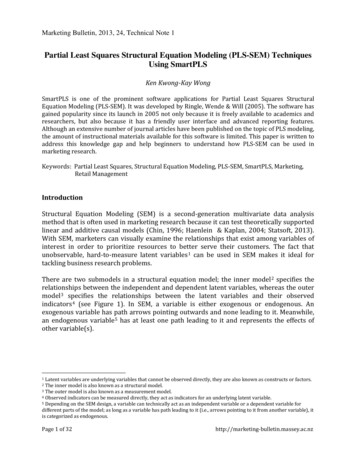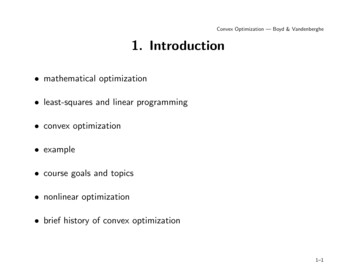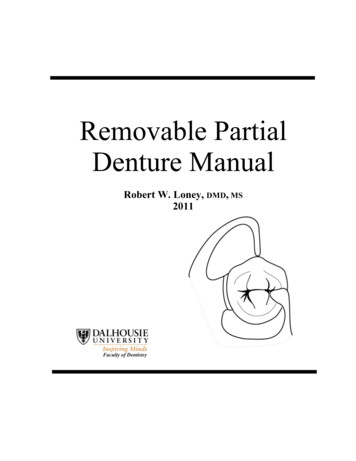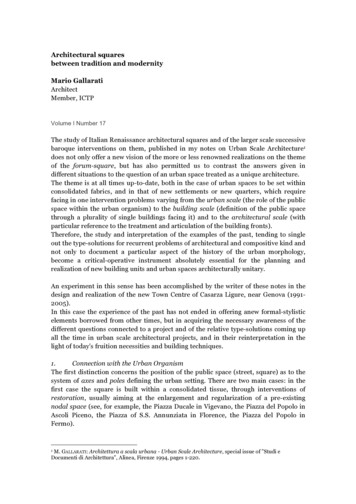
Transcription
Marketing Bulletin, 2013, 24, Technical Note 1Partial Least Squares Structural Equation Modeling (PLS-SEM) TechniquesUsing SmartPLSKen Kwong-Kay WongSmartPLS is one of the prominent software applications for Partial Least Squares StructuralEquation Modeling (PLS-SEM). It was developed by Ringle, Wende & Will (2005). The software hasgained popularity since its launch in 2005 not only because it is freely available to academics andresearchers, but also because it has a friendly user interface and advanced reporting features.Although an extensive number of journal articles have been published on the topic of PLS modeling,the amount of instructional materials available for this software is limited. This paper is written toaddress this knowledge gap and help beginners to understand how PLS-SEM can be used inmarketing research.Keywords: Partial Least Squares, Structural Equation Modeling, PLS-SEM, SmartPLS, Marketing,Retail ManagementIntroductionStructural Equation Modeling (SEM) is a second-generation multivariate data analysismethod that is often used in marketing research because it can test theoretically supportedlinear and additive causal models (Chin, 1996; Haenlein & Kaplan, 2004; Statsoft, 2013).With SEM, marketers can visually examine the relationships that exist among variables ofinterest in order to prioritize resources to better serve their customers. The fact thatunobservable, hard-to-measure latent variables 1 can be used in SEM makes it ideal fortackling business research problems.There are two submodels in a structural equation model; the inner model 2 specifies therelationships between the independent and dependent latent variables, whereas the outermodel 3 specifies the relationships between the latent variables and their observedindicators 4 (see Figure 1). In SEM, a variable is either exogenous or endogenous. Anexogenous variable has path arrows pointing outwards and none leading to it. Meanwhile,an endogenous variable 5 has at least one path leading to it and represents the effects ofother variable(s).Latent variables are underlying variables that cannot be observed directly, they are also known as constructs or factors.The inner model is also known as a structural model.3 The outer model is also known as a measurement model.4 Observed indicators can be measured directly, they act as indicators for an underlying latent variable.5 Depending on the SEM design, a variable can technically act as an independent variable or a dependent variable fordifferent parts of the model; as long as a variable has path leading to it (i.e., arrows pointing to it from another variable), itis categorized as endogenous.12Page 1 of 32http://marketing-bulletin.massey.ac.nz
Marketing Bulletin, 2013, 24, Technical Note 1Figure 1: Inner vs. Outer Model in a SEM DiagramDifferent Approaches to SEMThere are several distinct approaches to SEM: The first approach is the widely appliedCovariance-based SEM (CB-SEM) 6, using software packages such as AMOS, EQS, LISREL andMPlus. The second approach is Partial Least Squares (PLS), which focuses on the analysis ofvariance and can be carried out using PLS-Graph, VisualPLS, SmartPLS, and WarpPLS. It canalso be employed using the PLS module in the “r” statistical software package. The thirdapproach is a component-based SEM known as Generalized Structured ComponentAnalysis (GSCA); it is implemented through VisualGSCA or a web-based application calledGeSCA. Another way to perform SEM is called Nonlinear Universal Structural RelationalModeling (NEUSREL), using NEUSREL’s Causal Analytics software.Faced with various approaches to path modeling, one has to consider their advantages anddisadvantages to choose an approach to suit.6Covariance-based SEM (CB-SEM) is also known as Covariance Structure Analysis (CSA)Page 2 of 32http://marketing-bulletin.massey.ac.nz
Marketing Bulletin, 2013, 24, Technical Note 1(i) CB-SEM:CB-SEM has been widely applied in the field of social science during the past severaldecades, and is still the preferred data analysis method today for confirming or rejectingtheories through testing of hypothesis, particularly when the sample size is large, the datais normally distributed, and most importantly, the model is correctly specified. That is, theappropriate variables are chosen and linked together in the process of converting a theoryinto a structural equation model (Hair, Ringle, & Smarted, 2011; Hwang et al., 2010;Reinartz, Haenlein, & Henseler, 2009). However, many industry practitioners andresearchers note that, in reality, it is often difficult to find a data set that meets theserequirements. Furthermore, the research objective may be exploratory, in which we knowlittle about the relationships that exist among the variables. In this case, marketers canconsider PLS.(ii) PLS-SEM:PLS is a soft modeling approach to SEM with no assumptions about data distribution (Vinziet al., 2010). Thus, PLS-SEM becomes a good alternative to CB-SEM when the followingsituations are encountered (Bacon, 1999; Hwang et al., 2010; Wong, 2010):1.2.3.4.Sample size is small.Applications have little available theory.Predictive accuracy is paramount.Correct model specification cannot be ensured.It is important to note that PLS-SEM is not appropriate for all kinds of statistical analysis.Marketers also need to be aware of some weaknesses of PLS-SEM, including:1.2.3.4.High-valued structural path coefficients are needed if the sample size is small.Problem of multicollinearity if not handled well.Since arrows are always single headed, it cannot model undirected correlation.A potential lack of complete consistency in scores on latent variables may result inbiased component estimation, loadings and path coefficients.5. It may create large mean square errors in the estimation of path coefficient loading.In spite of these limitations, PLS is useful for structural equation modeling in appliedresearch projects especially when there are limited participants and that the datadistribution is skewed, e.g., surveying female senior executive or multinational CEOs(Wong, 2011). PLS-SEM has been deployed in many fields, such as behavioral sciences (e.g.,Bass et al, 2003), marketing (e.g., Henseler et al., 2009), organization (e.g., Sosik et al.,2009), management information system (e.g., Chin et al., 2003), and business strategy (e.g.,Hulland, 1999).Page 3 of 32http://marketing-bulletin.massey.ac.nz
Marketing Bulletin, 2013, 24, Technical Note 1(iii) GSCA & Other Approach:If overall measures of model fit are required, or in projects where non-linear latentvariables exist and have to be accommodated, GSCA may be a better choice than PLS forrunning structural equation modeling (Hwang et al., 2010). And for data sets thatdemonstrate significant nonlinearities and moderation effects among variables, theNEUSREL approach may be considered (Frank and Hennig-Thurau, 2008).However, since GSCA and NEUSREL are relatively new approaches in SEM, the amount ofliterature for review is limited. Marketers may find it difficult to locate sufficient examplesto understand how these emerging SEM approaches can be used in different businessresearch scenarios.Evolution of PLS-SEM SoftwareAlthough developed in the mid-1960s (Wold, 1973, 1985), there has been a lack ofadvanced yet easy-to-use PLS path modeling software (not to be confused with PLSregression as it is different from PLS-SEM) until mid 2000s. The first generation of PLSSEM software that was commonly used in the 1980s included LVPLS 1.8 but it was a DOSbased program. The subsequent arrival of PLS-Graph and VisualPLS added a graphicalinterface but they have received no significant updates since their initial releases. PLS-SEMcan be performed in “r” but it requires certain level of programming knowledge. Therefore,it may not be suitable for those marketers who do not have strong computer sciencebackground. The remaining PLS-SEM software packages, still in active development,include WarpPLS (a commercial software 7) and SmartPLS (a free software).This paper focuses on SmartPLS because it is freely available to the research communityacross the globe. Furthermore, this software has maintained an active online discussionforum 8, providing a good platform for knowledge exchange among its users.Determination of Sample Size in PLS-SEMNo matter which PLS-SEM software is being used, some general guidelines should befollowed when performing PLS path modeling. This is particularly important, as PLS is stillan emerging multivariate data analysis method, making it easy for researchers, academics,or even journal editors to let inaccurate applications of PLS-SEM go unnoticed. Determiningthe appropriate sample size is often the first headache faced by researchers.In general, one has to consider the background of the model, the distributionalcharacteristics of the data, the psychometric properties of variables, and the magnitude oftheir relationships when determining sample size. Hair et al. (2013) suggest that samplesize can be driven by the following factors in a structural equation model design:78WrapPLS has a 90-day fully functional free trial version that can be downloaded from the developer’s web site.Online forum is located at the developer’s web site (http://www.smartpls.de).Page 4 of 32http://marketing-bulletin.massey.ac.nz
Marketing Bulletin, 2013, 24, Technical Note 11.2.3.4.The significance levelThe statistical powerThe minimum coefficient of determination (R2 values) used in the modelThe maximum number of arrows pointing at a latent variableIn practice, a typical marketing research study would have a significance level of 5%, astatistical power of 80%, and R2 values of at least 0.25. Using such parameters, theminimum sample size required can be looked up from the guidelines suggested byMarcoulides & Saunders (2006), depending on the maximum number of arrows pointing ata latent variable as specified in the structural equation model (see Table 1):Table 1: Suggested Sample Size in a Typical Marketing ResearchMinimum samplesize required525965707580848891Maximum # of arrows pointing at a latent variable in the model2345678910Although PLS is well known for its capability of handling small sample sizes, it does notmean that your goal should be to merely fulfill the minimum sample size requirement.Prior research suggests that a sample size of 100 to 200 is usually a good starting point incarrying out path modeling (Hoyle, 1995). Please note that the required sample size willneed to be increased if the research objective is to explore low-value factorintercorrelations with indicators that have poor quality.Suggestions to ensure correct PLS applicationPLS is still considered by many as an emerging multivariate data analysis method, andresearchers are still exploring the best practices of PLS-SEM. Even so, some generalguidelines have been suggested in the literature. Table 2 displays some of guidelines thatshould be considered.Page 5 of 32http://marketing-bulletin.massey.ac.nz
Marketing Bulletin, 2013, 24, Technical Note 1Table 2: Some Guidelines on PLS ApplicationsTopics:Measurement scaleValue for outer weightMaximum number ofiterationsBootstrappingInner model evaluationOuter model evaluation(reflective)Outer model evaluation(formative)Suggestions:Avoid using a categorical scalein endogenous constructsUse a uniform value of 1 asstarting weight for theapproximation of the latentvariable score300Number of bootstrap “samples”should be 5000 and number ofbootstrap “cases” should be thesame as the number of validobservationsDo not use goodness-of-fit(GoF) Index 9Report indicator loadings. Donot use Cronbach’s alpha forinternal consistency reliability.Report indicator weights. Totest the outer model’ssignificance, report t-values, pvalues and standard errorsReferences:Hair et al., 2010Henseler, 2010Ringle et al., 2005Hair et al., 2011Henseler and Sarstedt, 2013Bagozzi and Yi, 1988-SmartPLS applied: An exampleThe following customer satisfaction example will be used to demonstrate how to use theSmartPLS software application.Customer satisfaction is an example of a latent variable that is multidimensional anddifficult to observe directly. However, one can measure it indirectly with a set ofmeasurable indicators 10 that serve as proxy. In order to understand customer satisfaction,a survey can be conducted to ask restaurant patrons about their dining experience. In thisfictitious survey example, restaurant patrons are asked to rate their experience on a scalerepresenting four latent variables, namely Customer Expectation (EXPECT), PerceivedQuality (QUAL), Customer Satisfaction (SAT), and Customer Loyalty (LOYAL), using a 7point Likert scales 11 [(1) strongly disagree, (2) disagree, (3) somewhat disagree, (4) neitheragree nor disagree, (5) somewhat agree, (6) agree, and (7) strongly agree]. The conceptualframework is visually shown in Figure 2, and the survey questions asked are presented inTable 3. Other than Customer Satisfaction (SAT) that is measured by one question, all othervariables (QUAL, EXPECT, & LOYAL) are each measured by three questions. This design isin line with similar researches conducted for the retail industry (Hair et al., 2013).The Goodness-of-fit (GoF) index is an index measuring the predictive performance of the measurement model.Specifically, it can be understood as the geometric mean of the average communality and the average R2 of theendogenous latent variables. See Esposito Vinzi et al. (2008, p. 444) and Henseler & Sarstedt (2013, p570)10 Indicators are also known as items or manifest variables.11 An alternative approach is to use a 10-point Likert scale.9Page 6 of 32http://marketing-bulletin.massey.ac.nz
Marketing Bulletin, 2013, 24, Technical Note 1Figure 2: Conceptual Framework – Restaurant ExampleTable 3: Questions for Indicator Variablesexpect 1expect 2expect 3qual 1qual 2qual 3cxsatloyal 1loyal 2loyal 3Page 7 of 32Customer Expectation (EXPECT)[this restaurant] has the best menu selection.[this restaurant] has the great atmospheric elements.[this restaurant] has good looking servers.Perceived Quality (QUAL)The food in [this restaurant] is amazing with great taste.Servers in [this restaurant] are professional, responsive, and friendly.[this restaurant] provides accurate bills to customers.Customer Satisfaction (SAT)If you consider your overall experiences with [this restaurant], how satisfied areyou with [this restaurant]?Customer Loyalty (LOYAL)I would recommend [this restaurant] to my friends and relatives.I would definitely dine at [this restaurant] again in the near future.If I had to choose again, I would choose [this restaurant] as the venue for thisdining experience.http://marketing-bulletin.massey.ac.nz
Marketing Bulletin, 2013, 24, Technical Note 1Installing the SmartPLS software applicationSmartPLS can be downloaded for free from the software developer’s official website atwww.smartpls.de. A free account registration is required prior to downloading thesoftware (see Figure 3). Since SmartPLS is primarily designed for the academic community,the account set up request is manually reviewed by the software developer team inGermany. It may take up to a few business days to set up an account with SmartPLS as theprocess is not automatic.Figure 3: SmartPLS Account RegistrationThe SmartPLS software application can be found in the “Downloads” section located in theupper right hand corner of the discussion forum page (see Figure 4). Microsoft Windowsuser should download the “win32 (win32/x86)” version for installation. AlthoughSmartPLS is written in Java, Intel-based Apple Mac users should utilize visualizationsoftware 12 or Apple’s own Bootcamp function to run SmartPLS under the Windows OSenvironment 13. This is because the “Macosx (carbon/ppc)” version is not compatible withthe latest MacOS (e.g., 10.7, 10.8 and 10.9). The software requires a personal SmartPLSactivation key to run and it can be generated by pressing the “My Key” link on the sameweb page. Please note that such activation key has to be renewed every three months forcontinuous usage of the software.1213Examples include VMware Fusion, Parallels Desktop, and Oracle’s VirtualBox.Examples include Windows XP, VISTA, 7 and 8.Page 8 of 32http://marketing-bulletin.massey.ac.nz
Marketing Bulletin, 2013, 24, Technical Note 1Figure 4: SmartPLS Discussion ForumData Preparation for SmartPLSIn this restaurant example, the survey data were manually typed into Microsoft Excel andsaved as .xlsx format (see Figure 5). This data set has a sample size of 400 without anymissing values, invalid observations or outliers. To ensure SmartPLS can import the Exceldata properly, the names of those indicators (e.g., expect 1, expect 2, expect 3) should beplaced in the first row of an Excel spreadsheet, and that no “string” value (e.g., words orsingle dot 14) is used in other cells.14A single dot “.” is usually generated by IBM SPSS Statistics to represent a missing value.Page 9 of 32http://marketing-bulletin.massey.ac.nz
Marketing Bulletin, 2013, 24, Technical Note 1Figure 5 – Dataset from the Restaurant ExampleSince SmartPLS cannot take native Excel file format directly, the data set has to beconverted into .csv file format 15. To do this, go to the “File” menu in Excel, and choose “CSV(Comma Delimited)” as the file format type to save it onto your computer (see Figure 6).Figure 6: Save file as “CSV format” in Excel15SmartPLS can only open .csv or .txt file formatsPage 10 of 32http://marketing-bulletin.massey.ac.nz
Marketing Bulletin, 2013, 24, Technical Note 1Project Creation in SmartPLSNow, launch the SmartPLS program and go to the “File” menu to create a new project. Wewill name this project as “restaurant” and then import the indicator data. Since there is nomissing value 16 in this restaurant data set, we can press the “Finish” button to create thePLS file. Once the data set is loaded properly into SmartPLS, click the little “ ” sign next torestaurant to open up the data in the “Projects” tab. (see Figure 7).Figure 7: Project SelectionUnder the “restaurant” project directory, a “restaurant.splsm” PLS file and a corresponding“restaurant.csv” data file are displayed 17. Click on the first one to view the manifestvariables under the “Indicators” tab (see Figure 8).For other data sets that include missing values, a replacement value of “-9999” is suggested. However, please note thatyou can only specify a single value for all missing data in SmartPLS.17 For each project, you can have more than one path model (i.e., the .splsm file) and dataset (i.e., .csv file).16Page 11 of 32http://marketing-bulletin.massey.ac.nz
Marketing Bulletin, 2013, 24, Technical Note 1Figure 8: List of IndicatorsBuilding the Inner ModelBased on the conceptual framework that has been designed earlier in this paper (see Figure2), an inner model can be built easily in SmartPLS by first clicking on the modeling windowon the right hand side, and then selecting the 2nd last blue-color circle icon titled “Switch toInsertion Mode”. Click in the window to create those red-color circles that represent yourlatent variables. Once the circles are placed, right click on each latent variable to change thedefault name into the appropriate variable name in your model. Press the last icon titled“Switch to Connection Mode” to draw the arrows to connect the variables together (seeFigure 9).Page 12 of 32http://marketing-bulletin.massey.ac.nz
Marketing Bulletin, 2013, 24, Technical Note 1Figure 9: Building the Inner ModelBuilding the Outer ModelThe next step is to build the outer model. To do this, link the indicators to the latentvariable by dragging them one-by-one from the “Indicators” tab to the corresponding redcircle. Each indicator is represented by a yellow rectangle and the color of the latentvariable will be changed from red to blue when the linkage is established. The indicatorscan be easily relocated on the screen by using the “Align Top/Bottom/Left/Right” function,if you right click on the blue-color latent variable. The resulting model should look likethose in Figure 10.Page 13 of 32http://marketing-bulletin.massey.ac.nz
Marketing Bulletin, 2013, 24, Technical Note 1Figure 10: Building the Outer ModelFormative vs. Reflective MeasurementThere are two types of measurement scale in structural equation modeling; it can beformative or reflective.Formative Measurement ScaleIf the indicators cause the latent variable and are not interchangeable among themselves,they are formative. In general, these formative indicators can have positive, negative, oreven no correlations among each other (Haenlein & Kaplan, 2004; Petter et al., 2007). Assuch, there is no need to report indicator reliability, internal consistency reliability, anddiscriminant validity if a formative measurement scale is used. This is because outerloadings, composite reliability, and square root of average variance extracted (AVE) aremeaningless for a latent variable made up of uncorrelated measures.A good example of formative measurement scale is the measurement of employee’s stresslevel. Since it is a latent variable that is often difficult to measure directly, researchers haveto look at indicators such as divorce, job loss and car accident that can be measured. Here,it is obvious that car accident does not necessary have anything to do with divorce or jobloss, and these indicators are not interchangeable.Page 14 of 32http://marketing-bulletin.massey.ac.nz
Marketing Bulletin, 2013, 24, Technical Note 1When formative indicators exist in the model, the direction of the arrows has to bereversed. That is, the arrow should be pointing from the yellow-color formative indicatorsto the blue-color latent variable in SmartPLS. This can be done easily by right clicking onthe latent variable and selecting “Invert measurement model” to change the arrowdirection.Reflective Measurement ScaleIf the indicators are highly correlated and interchangeable, they are reflective and theirreliability and validity should be thoroughly examined (Haenlein & Kaplan, 2004; Hair etal., 2013; Petter et al., 2007). For example, the latent variable Perceived Quality (QUAL) inour restaurant data set is made up of three observed indicators: food taste, serverprofessionalism, and bill accuracy. Their outer loadings, composite reliability, AVE and itssquare root should be examined and reported.In a reflective measurement scale, the causality direction is going from the blue-color latentvariable to the yellow-color indicators. It is important to note that by default, SmartPLSassumes the indicators are reflective when the model is built, with arrows pointing awayfrom the blue-color latent variable. One of the common mistakes that researchers madewhen using SmartPLS is that they forget to change the direction of the arrows when theindicators are “formative” instead of “reflective”. Since all of the indicators in thisrestaurant example are reflective, there is no need to change the arrow direction.We will continue to explore this reflective example and once the PLS-SEM analysis is done,discussion of a formative measurement model will follow.Running the Path-Modeling EstimationOnce the indicators and latent variables are linked together successfully in SmartPLS (i.e.,no more red-color circles and arrows), the path modeling procedure can be carried out bygoing to the “Calculate” menu and selecting “PLS Algorithm”. If the menu is dimmed, justclick on the main modeling window to activate it. A pop-up window will be displayed toshow the default settings. Since there is no missing value 18 for our data set, we proceeddirectly to the bottom half of the pop-up window to configure the “PLS Algorithm –Settings” with the following parameters (see Figure 11):1.2.3.4.5.Weighting Scheme: Path Weighting SchemeData Metric: Mean 0, Variance 1Maximum Iterations: 300Abort Criterion: 1.0E-5Initial Weights: 1.0If there is a missing value in your dataset, choose “Mean Value Replacement” rather than “Case Wise Deletion”, as it isthe recommended option for PLS-SEM.18Page 15 of 32http://marketing-bulletin.massey.ac.nz
Marketing Bulletin, 2013, 24, Technical Note 1Figure 11: Configuring the PLS AlgorithmTo run the path modeling, press the “Finish” button. There should be no error messages 19popping up on the screen, and the result can now be assessed and reported.Assessing the PLS-SEM OutputFor an initial assessment of PLS-SEM model, some basic elements should be covered inyour research report. If a reflective measurement model is used, as in our restaurantexample, the following topics have to be discussed: Explanation of target endogenous variable varianceInner model path coefficient sizes and significanceOuter model loadings and significanceIndicator reliabilityInternal consistency reliabilityConvergent validity 20Discriminant validityChecking Structural Path Significance in BootstrappingIf your data set has an indicator that includes too many identical values, the variance will become zero and lead to a“singular data matrix” error. To fix it, simply remove that indicator from your model.20 Note that convergent validity and discriminant validity are measures of construct validity. They do not negate the needfor considered selection of measures for proper content and face validity.19Page 16 of 32http://marketing-bulletin.massey.ac.nz
Marketing Bulletin, 2013, 24, Technical Note 1On the other hand, if the model has a formative measurement, the following should bereported instead: Explanation of target endogenous variable varianceInner model path coefficient sizes and significanceOuter model weight and significanceConvergent validityCollinearity among indicatorsSmartPLS presents path modeling estimations not only in the Modeling Window but also ina text-based report 21 which is accessible via the “Report” menu. In the PLS-SEM diagram,there are two types of numbers:1.2.Numbers in the circle: These show how much the variance of the latent variableis being explained by the other latent variables.Numbers on the arrow: These are called the path coefficients. They explain howstrong the effect of one variable is on another variable. The weight of differentpath coefficients enables us to rank their relative statistical importance. 22Figure 12: PLS-SEM ResultsDefault Report is the preferred one. You can also choose HTML Report or LaTex Report depending on your needs.In general, for data set that has up to 1000 observations or samples, the “standardized” path coefficient should be largerthan 0.20 in order to demonstrate its significance. Also note that the relative statistical importance of a variable is not thesame as its strategic or operational importance.2122Page 17 of 32http://marketing-bulletin.massey.ac.nz
Marketing Bulletin, 2013, 24, Technical Note 1The PLS path modeling estimation for our restaurant example is shown in Figure 12. Bylooking at the diagram, we can make the following preliminary observations:(i)Explanation of target endogenous variable variance (ii)The coefficient of determination, R2, is 0.572 for the LOYAL endogenous latentvariable. This means that the three latent variables (QUAL, EXPECT, and CXSAT)moderately 23 explain 57.2% of the variance in LOYAL.QUAL and EXPECT together explain 30.8% of the variance of CXSAT. 24Inner model path coefficient sizes and significance (iii)The inner model suggests that CXSAT has the strongest effect on LOYAL (0.504),followed by QUAL (0.352) and EXPECT (0.003).The hypothesized path relationship between QUAL and LOYAL is statisticallysignificant.The hypothesized path relationship between CXSAT and LOYAL is statisticallysignificant.However, the hypothesized path relationship between EXPECT and LOYAL is notstatistically significant 25. This is because its standardized path coefficient (0.003) islower than 0.1. Thus we can conclude that: CXSAT and QUAL are both moderatelystrong predictors of LOYAL, but EXPECT does not predict LOYAL directly.Outer model loadingsTo view the correlations between the latent variable and the indicators in its outer model,go to “Report” in the menu and choose “Default Report”. Since we have a reflective model inthis restaurant example, we look at the numbers as shown in the “Outer Loadings” 26window (PLS Calculation Results Outer Loadings). We can press the “Toggle ZeroValues” icon to remove the extra zeros in the table for easier viewing of the pathcoefficients (see Figure 13).In marketing research, R2 of 0.75 is substantial, 0.50 is moderate, and 0.25 is weak.CXSAT acts as both independent and dependent variable in this example and is placed in the middle of the model. It isconsidered to be an endogenous variable as it has arrows pointing from other latent variables (QUAL and EXPECT) to it.As a rule of thumb, exogenous variable only has arrows pointing away from it.25 In SmartPLS, the bootstrap procedure can be used to test the significance of a structural path using T-Statistic. Thistopic is discussed later in the paper.26 If a “formative” measurement model is used, view “Outer Weights” instead.2324Page 18 of 32http://marketing-bulletin.massey.ac.nz
Marketing Bulletin, 2013, 24, Technical Note 1Figure 13: Path Coefficient Estimation in the Outer ModelIn SmartPLS, the software will stop the estimation when (i) the stop criterion of thealgorithm was reached, or (ii) the maximum number of iterations has reached, whichevercomes first. Since we intend to obtain a stable estimation, we want the algorithm toconverge before reaching the maximum number of iterations. To see if that is the case, goto “Stop Criterion Changes” (see Figure 14) to determine how many iterations have beencarried out. In this restaurant example, the algorithm converged only after 4 iterations(instead of reaching 300), so our estimation is good 27.27 If the PLS-SEM algorithm cannot converge your data in less than 300 iterations, it means
Predictive accuracy is paramount. 4. Correct model specification cannot be ensured. . PLS is useful for structural equation modeling in applied research projects especially when there are limited participants and that the data distribution is skewed, e.g., surveying female senior executive or multinational CEOs





![[SEM] Structural Equation Modeling - Stata](/img/31/sem.jpg)




